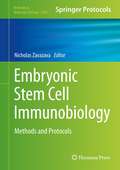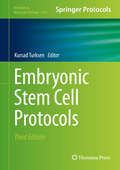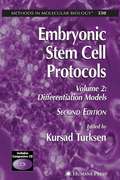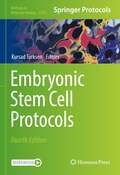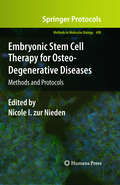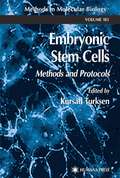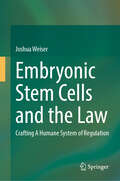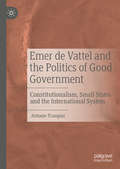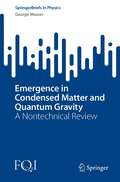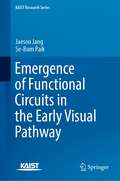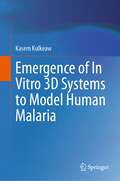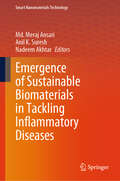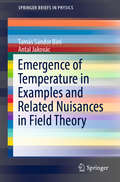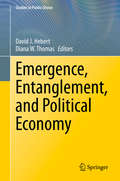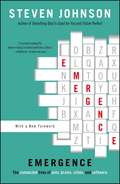- Table View
- List View
Embryology and the Rise of the Gothic Novel (Palgrave Studies in Literature, Science and Medicine)
by Diana Pérez EdelmanThis book argues that embryology and the reproductive sciences played a key role in the rise of the Gothic novel in the eighteenth and nineteenth centuries. Diana Pérez Edelman dissects Horace Walpole’s use of embryological concepts in the development of his Gothic imagination and provides an overview of the conflict between preformation and epigenesis in the scientific community. The book then explores the ways in which Gothic literature can be read as epigenetic in its focus on internally sourced modes of identity, monstrosity, and endless narration. The chapters analyze Horace Walpole’s The Castle of Otranto; Ann Radcliffe’s A Sicilian Romance, The Italian, and The Mysteries of Udolpho; Mary Shelley’s Frankenstein; Charles Robert Maturin’s Melmoth the Wanderer; and James Hogg’s Confessions of a Justified Sinner, arguing that these touchstones of the Gothic register why the Gothic emerged at that time and why it continues today: the mysteries of reproduction remain unsolved.
Embryology of Flowering Plants: Reproductive Systems (Embryology Of Flowering Plants Ser.)
by T. B. BatyginaPlant embryology, dealing with the regularities of initiation and the first stages of development of an organism, is now flourishing because of the overall progress being made in natural sciences. Such discoveries of the 20th century as production of plants from a single somatic cell, experimental haploidy, and parasexual hybridization were of general biological significance. The combined efforts of embryologists, geneticists and molecular biologists yielded the discovery of specific genes that control meiosis, egg cell development and early stages of embryogenesis. The tendency to synthesize data of embryology and genetics has become increasingly noticeable. It is connected with the fact that the majority of problems connected with morphogenesis, such as differentiation, specialization, the evaluation of features and the definition of the notionsgene and feature andgenotype and phenotype concern embryology and genetics (embryogenetics) in one way or another. Evolutionary embryology has given rise to a new approach to the study of problems of adaptation in plants. In connection with the problem of preserving biological diversity under conditions of ecological stress, special attention is paid to ecological embryology, revealing the critical periods in early ontogenesis and plasticity and tolerance of reproductive systems at the level of species and population. The study of variability of morphogenesis and phenotype in population (life cycle variations and the diversity of reproductive systems) is the most important point in the population embryology of plants.
Embryonic Stem Cell Immunobiology
by Nicholas ZavazavaBone marrow stem cells are the most transplanted cells worldwide. These cells are used as a replacement therapy for patients suffering from a diverse number of hematopoietic diseases and immunodeficiencies. However, the use of bone marrow cells in regenerative medicine has so far remained without much success. In the new era of pluripotent stem cells, great opportunities for establishing new therapies have opened up. The discovery of human embryonic stem cells and that of induced pluripotent (iPS) stem cells has made it possible to derive any desired tissues for regenerative medicine as iPS cell derived cells are only limited by the lack of established protocols that can be applied in humans. There is no doubt that stem cells present a new and innovative platform for establishing novel cell based therapies. The challenge is to establish new protocols that allow the successful differentiation of these cells into lineage committed cells. Embryonic Stem Cell Immunobiology: Methods and Protocols covers a variety of relevant topics, such as hematopoietic stem cells derived from ES cells, the interaction of these cells with natural killer cells or with cytotoxic T cells, and specific protocols for the derivation of hematopoietic cells and neuronal cells, to name a few. Written in the highly successful Methods in Molecular Biology series format, chapters contain introductions to their respective topics, lists of the necessary materials and reagents, step-by-step, readily reproducible laboratory protocols, and notes on troubleshooting and avoiding known pitfalls. Authoritative and accessible, Embryonic Stem Cell Immunobiology: Methods and Protocols serves as an ideal guide to experts and non-experts interested in different aspects of stem cells.
Embryonic Stem Cell Protocols, 3rd Edition
by Kursad TurksenThis extensive volume explores areas of intense activity related to the very early commitment of stem cells to particular lineages and the progression of differentiation to mature cell stages. Research on embryonic stem cells continues to move very quickly, thus the kinds of studies continue to expand and diversify, and methodologies are continuously being refined and improved, which this book reflects. Written in the highly successful Methods in Molecular Biology series format, chapters include introductions on their respective topics, lists of the necessary materials and reagents, step-by-step, readily reproducible laboratory protocols, and tips on troubleshooting and avoiding known pitfalls.<P><P> Comprehensive and fully updated, Embryonic Stem Cell Protocols, Third Edition serves as an ideal reference for researchers investigating this rich area of study.
Embryonic Stem Cell Protocols, Volume II: Differentiation Models, 2nd Edition
by Kursad TurksenDrawing on the dramatically increasing research on embryonic stem (ES) cell biology and differentiation, Kursad Turksen has completely updated and expanded his highly acclaimed first edition of Embryonic Stem Cells: Methods and Protocols into two volumes. The second volume, Embryonic Stem Cell Protocols: Differentiation Models, Second Edition, covers state-of-the-art methods for deriving many types of differentiating cells from ES cells. A companion first volume, Embryonic Stem Cell Protocols: Isolation and Characterization, Second Edition, focuses on ES cells recently isolated from different nonhuman species, to provide a diverse collection of readily reproducible cellular and molecular protocols for the isolation, maintenance, and characterization of embryonic stem cells. The protocols follow the successful Methods in Molecular Biology™ series format, each offering step-by-step laboratory instructions, an introduction outlining the principles behind the technique, lists of the necessary equipment and reagents, and tips on troubleshooting and avoiding known pitfalls. <P><P> Authoritative and cutting-edge, the two volumes of Embryonic Stem Cells illuminate for both novices and experts not only our current understanding of the biology of embryonic stem cells and their utility in normal tissue homeostasis and regenerative medicine applications, but also provide detailed accounts of the tools required for successful work in the area.
Embryonic Stem Cell Protocols: Isolation And Characterization (Methods in Molecular Biology #2520)
by Kursad TurksenThis fully updated volume explores improved and extended protocols for embryonic stem cell (ESC) research, provided with the most direct and informative methodologies currently available. The book examines how these models for cell lineage and differentiation studies have continued to mature into a critical research workhorse. Written for the highly successful Methods in Molecular Biology series format, chapters include introductions to their respective topics, lists of the necessary materials and reagents, step-by-step, readily reproducible laboratory protocols, and tips on troubleshooting and avoiding known pitfalls. Authoritative and up-to-date, Embryonic Stem Cell Protocols, Fourth Edition serves as an ideal resource for researching mining the depths of the ESC field.
Embryonic Stem Cell Therapy for Osteo-Degenerative Diseases
by Nicole I. NiedenEmbryonic stem cells (ESCs) offer an unlimited self-renewing capacity, as opposed to the limits of adult stem cells; therefore, ESCs represent an almost bottomless resource for regenerative medicine and tissue engineering approaches. In Embryonic Stem Cell Therapy for Osteo-Degenerative Diseases: Methods and Protocols, accomplished investigators provide detailed descriptions on how to expand ESCs from the most commonly used species ex vivo, i.e. mouse and human, in static culture as well as in controllable bioreactor processes. The thorough and timely volume summarizes the methods that may be used to differentiate these cells along the desired lineage of choice, be it osteoblasts, osteoclasts, or chondrocytes, and consequentially also offers analysis tools for the characterization of resulting cells and evaluation of differentiation effectiveness. Written in the highly successful Methods in Molecular BiologyTM series format, chapters include introductions to their respective topics, lists of the necessary materials and reagents, step-by-step, readily reproducible laboratory protocols, and expert tips on troubleshooting and avoiding known pitfalls. Dependable and cutting-edge, Embryonic Stem Cell Therapy for Osteo-Degenerative Diseases: Methods and Protocols supplies the tools necessary to allow researchers to carry out critical research needed in order to bring this burgeoning and vitally important field closer to the clinic and to ensure the widespread application of a successful strategy.
Embryonic Stem Cells
by Kursad TurksenKursad Turksen and a panel of international experts describe their most productive methods for using embryonic stem (ES) cells as in vitro developmental models for many cell and tissue types. Set out in step-by-step detail, these protocols range widely from ES cell isolation, maintenance, and modulation of gene expression, to cutting-edge techniques that use cDNA arrays in gene expression analysis and phage display libraries, the generation of antibodies against very rare antigens, and the identification of and characterization of protein and protein interactions. Embryonic Stem Cells: Methods and Protocols will prove an invaluable resource not only for those interested generally in cell and developmental biology, but also for those actively using, or planning to use ES cells, to study fate choices and specific lineages.
Embryonic Stem Cells and the Law: Crafting A Humane System of Regulation
by Joshua WeiserThis book deals with the research and use of embryonic stem cells to combat a number of diseases and the legal limitations, arising mostly from bioethical concerns regarding human life. Using the New Haven problem and policy-oriented method of jurisprudence, the author thoroughly explains the scientific and technological parameters and promise of this medical innovation and its alternatives as well as the conflicting claims and past decisions regarding its legal and moral acceptability in international and comparative perspective. International law, EU and regional human rights law, as well as individual countries’ laws across the globe are covered, ending with American law on the federal and state levels. The book concludes with a recommendation of humane regulation, and a draft federal statute as a model form of regulation that would allow the beneficial research and use of this technology.
Embryos in Deep Time
by Marcelo R. SánchezHow can we bring together the study of genes, embryos and fossils? Embryos in Deep Time is a critical synthesis of the study of individual development in fossils. It brings together an up-to-date review of concepts from comparative anatomy, ecology and developmental genetics, and examples of different kinds of animals from diverse geological epochs and geographic areas. Can fossil embryos demonstrate evolutionary changes in reproductive modes? How have changes in ocean chemistry in the past affected the development of marine organisms? What can the microstructure of fossil bone and teeth reveal about maturation time, longevity and changes in growth phases? This book addresses these and other issues and documents with numerous examples and illustrations how fossils provide evidence not only of adult anatomy but also of the life history of individuals at different growth stages. The central topic of Biology today--the transformations occurring during the life of an organism and the mechanisms behind them--is addressed in an integrative manner for extinct animals.
Embryos under the Microscope
by Jane MaienscheinToo tiny to see with the naked eye, the human embryo was just a hypothesis until the microscope made observation of embryonic development possible. This changed forever our view of the minuscule cluster of cells that looms large in questions about the meaning of life. Embryos under the Microscope examines how our scientific understanding of the embryo has evolved from the earliest speculations of natural philosophers to today's biological engineering, with its many prospects for life-enhancing therapies. Jane Maienschein shows that research on embryos has always revealed possibilities that appear promising to some but deeply frightening to others, and she makes a persuasive case that public understanding must be informed by up-to-date scientific findings. Direct observation of embryos greatly expanded knowledge but also led to disagreements over what investigators were seeing. Biologists confirmed that embryos are living organisms undergoing rapid change and are not in any sense functioning persons. They do not feel pain or have any capacity to think until very late stages of fetal development. New information about DNA led to discoveries about embryonic regulation of genetic inheritance, as well as evolutionary relationships among species. Scientists have learned how to manipulate embryos in the lab, taking them apart, reconstructing them, and even synthesizing--practically from scratch--cells, body parts, and maybe someday entire embryos. Showing how we have learned what we now know about the biology of embryos, Maienschein changes our view of what it means to be alive.
Embryos, Galaxies, and Sentient Beings
by John E. Upledger Richard Grossinger Harold B. DowseWhy is the universe conscious? What kindles mind inside matter? Why do fundamentalist sciences and religions never ask these questions? This sequel to Embryogenesis deals with the theoretical issues brought up by Embryogenesis, including: the relationship between thermodynamics/entropy and the emergence of life; a speculative set of embryogenic principles for all creatures on all planets in the cosmos; an explanation and critique of Intelligent Design and a proposal for a more dynamic psychospiritual theory of creature development; a series of alternatives to genetic determinism; a discussion of the relationship between consciousness and matter; an interjection of 9/11 (which occurred during the writing of this book); and many other topics. Chapters include: What is Life?: Evolution, Thermodynamics, and Complexity; Is There a Plan?: Creationism, Cultural Relativism, and Paraphysics; Biogenesis and Cosmogenesis: Cells, Genes, and Planets; The Principles of Biological Design: Physical Forces in Nature; The Dynamics of the Biosphere: Deep Time and Space; The Limits of Genetic Determinism: Dimensionless Epigenetic Landscapes; Topokinesis: Physical Forces in Development; Tissue Motifs and Body Plans: Coordinating Form; The Primordial Field: Metabiology and The Molecular Apparatus; Meaning and Destiny: The Relation of Consciousness to Matter
Emer de Vattel and the Politics of Good Government: Constitutionalism, Small States and the International System
by Antonio TrampusThis book explores the history of the international order in the eighteenth and nineteenth century through a new study of Emer de Vattel’s Droit des gens (1758). Drawing on unpublished sources from European archives and libraries, the book offers an in-depth account of the reception of Vattel’s chief work. Vattel’s focus on the myth of good government became a strong argument for republicanism, the survival of small states, drafting constitutions and reform projects and fighting everyday battles for freedom in different geographical, linguistic and social contexts. The book complicates the picture of Vattel’s enduring success and usefulness, showing too how the work was published and translated to criticize and denounce the dangerousness of these ideas. In doing so, it opens up new avenues of research beyond histories of international law, political and economic thought.
Emergence and Expansion of Pre-Classical Mechanics (Boston Studies in the Philosophy and History of Science #270)
by Jürgen Renn Matthias Schemmel Matteo Valleriani Rivka FeldhayThis book is divided into two sections. The first section is concerned with the emergence and expansion of a form of mechanical knowledge defined by us as pre-classical mechanics. The definition purports to the period roughly between the 15th and the 17th century, before classical mechanics was formulated as a coherent and comprehensive mechanical theory in the sequel of Newton's work. The investigation of problems that were isolated from each other at the time but cohered into some kind of stable broad intellectual framework characterizes pre-classical mechanics. The second section is dedicated to specific case studies that present the application of a pre-classical framework to determined problems and to the investigation of specific natural phenomena. It consists of five case studies that illustrate in detail a reconstruction of pre-classical mechanics in particular constellations. Early modern theoretical, technical and social contexts transformed ancient and medieval mechanical knowledge in the course of its transmission.
Emergence and Modularity in Life Sciences
by Ulrich Lüttge Lars H. WegnerThis book focuses on modules and emergence with self-organization in the life sciences. As Aristotle observed so long ago, the whole is more than the sum of its parts. However, contemporary science is dominated by reductionist concepts and tends to neglect the non-reproducible features of complex systems, which emerge from the interaction of the smaller units they are composed of. The book is divided into three major parts; the essays in part A highlight the conceptual basis of emergence, linking it to the philosophy of science, systems biology and sustainability. This is subsequently exemplified in part B by applying the concept of emergence to various biological disciplines, such as genetics, developmental biology, neurobiology, plant physiology and ecology. New aspects of emergence come into play when biology meets the technical sciences, as revealed in a chapter on bionics. In turn, part C adopts a broader view, revealing how the organization of life follows a hierarchical order in terms of scalar dimensions, ranging from the molecular level to the entire biosphere. The idea that life is primarily and exclusively shaped by processes at the molecular level (and, in particular, by the information encoded in the genome) is refuted; rather, there is no hierarchy with respect to the level of causation in the cross-talk between the levels. In the last two chapters, the evolutionary trend toward ever-increasing complexity in living systems is interpreted in terms of the Gaia hypothesis sensu Lovelock: the entire biosphere is viewed as a functional unit (or ‘holobiont-like system’) organized to develop and sustain life on Earth.
Emergence in Condensed Matter and Quantum Gravity: A Nontechnical Review (SpringerBriefs in Physics)
by George MusserThis book surveys the science at a semipopular, Scientific American-level. It is even-handed with regard to competing directions of research and philosophical positions. It is hard to get even two people to agree on anything, yet a million billion water molecules can suddenly and abruptly coordinate to lock themselves into an ice crystal or liberate one another to billow outwards as steam. The marvelous self-organizing capacity of matter is one of the central and deepest puzzles of physics, with implications for all the natural sciences. Physicists in the past century have found a remarkable diversity of phases of matter—and equally remarkable commonalities within that diversity. The pace of discovery has, if anything, only quickened in recent years with the appreciation of quantum phases of matter and so-called topological order. The study of seemingly humdrum materials has made contact with the more exotic realm of quantum gravity, as theorists realize that the spacetime continuum may itself be a phase of some deeper and still unknown constituents. These developments flesh out the sometimes vague concept of the emergence—how exactly it is that complexity begets simplicity.
Emergence in Science and Philosophy (Routledge Studies In The Philosophy Of Science Ser. #6)
by Antonella CorradiniThe concept of emergence has seen a significant resurgence in philosophy and the sciences, yet debates regarding emergentist and reductionist visions of the natural world continue to be hampered by imprecision or ambiguity. Emergent phenomena are said to arise out of and be sustained by more basic phenomena, while at the same time exerting a "top-down" control upon those very sustaining processes. To some critics, this has the air of magic, as it seems to suggest a kind of circular causality. Other critics deem the concept of emergence to be objectionably anti-naturalistic. Objections such as these have led many thinkers to construe emergent phenomena instead as coarse-grained patterns in the world that, while calling for distinctive concepts, do not "disrupt" the ordinary dynamics of the finer-grained (more fundamental) levels. Yet, reconciling emergence with a (presumed) pervasive causal continuity at the fundamental level can seem to deflate emergence of its initially profound significance. This basic problematic is mirrored by similar controversy over how best to characterize the opposite systematizing impulse, most commonly given an equally evocative but vague term, "reductionism." The original essays in this volume help to clarify the alternatives: inadequacies in some older formulations and arguments are exposed and new lines of argument on behalf the two visions are advanced.
Emergence of Functional Circuits in the Early Visual Pathway (KAIST Research Series)
by Jaeson Jang Se-Bum PaikThis book discusses the emergence of diverse functional organizations in the visual pathway which could be spontaneously and solely initiated by the random feedforward wiring of neural circuits. It demonstrates that the structure of ON and OFF retinal ganglion cell (RGC) mosaics is projected onto V1 by retino-cortical feedforward mapping to induce higher cognitive functions. This book will be beneficial for both theoretical and experimental neuroscientists, as well as for researchers using brain-inspired neural network models.
Emergence of In Vitro 3D Systems to Model Human Malaria
by Kasem KulkeawThis book illustrates the importance and advances of the disease model for malaria, a globally affected public health problem. This book provides comprehensive information on the malaria biology in a liver and all in vitro platforms for liver-stage malaria, including principles, protocols, applications for disease modeling and drug screening, and their limitations. The initial chapter describes the basis of stem cells in liver generation during development and in adults. The subsequent chapters highlight recent and emerging advances in liver organoid and liver-on-a-chip in modeling malaria. The book presents current protocols and methods to generate liver organoid and liver-on-a-chip together with their advantages and limitations. Toward the end, the book examines the humanized mouse model of liver-stage malaria using ectopic artificial livers regarding novel readout modalities. The recent advancement and challenges in combining liver-on-a-chip technology with biosensors are highlighted for assessing hepatocyte development viability and functions. The book elucidates the potential of these 3D models to understand the biological complexity of cellular and molecular mechanisms involved in Plasmodium development in the liver, toolboxes to investigate parasite deployment in the 3D models, and to implement in drug discovery. Finally, the book discusses the future directions and challenges in the applications of liver organoids and liver on-chip in the biology of live-stage malaria. This book is helpful for researchers and scientists in the field of parasitology, cell biology, tissue engineering, and pharmacology.
Emergence of Sustainable Biomaterials in Tackling Inflammatory Diseases (Smart Nanomaterials Technology)
by Anil K. Suresh Nadeem Akhtar Md. Meraj AnsariThis book presents the latest technology of sustainable nanomaterials for applications as drug delivery cargos in tackling various inflammatory diseases. The chapters in this book describe nanotechnology-based drug delivery strategies, the mechanistic insights of nanoformulations and their application in managing inflammation diseases such as rheumatoid arthritis, ulcerative colitis, cancer and neurological disorder. It looks into the challenges of using nanomaterials-based smart materials for enhanced therapeutic efficacy while maintaining safe and sustainable procedures. The book is divided into three main sections: A) Fundamental of smart nanocarriers and nanoformulations targeted drug delivery in inflammatory disease; B) Smart nano drug delivery therapy- an emerging approach towards inflammatory diseases and C) Novel nano delivery strategies in targeting major inflammatory diseases. The book targets early researchers and clinical practitioners who are interested in the management and treatment of inflammatory diseases using nanotechnology-based drug delivery systems.
Emergence of Temperature in Examples and Related Nuisances in Field Theory (SpringerBriefs in Physics)
by Antal Jakovác Tamás Sándor BiróField theory, relying on the concept of continuous space and time while confronted with the quantum physical nature of observable quantities, still has some fundamental challenges to face. One such challenge is to understand the emergence of complexity in the behavior of interacting elementary fields, including among other things nontrivial phase structures of elementary matter at high energy density or an atypical emergence of statistical properties, e.g., when an apparent temperature is proportional to a constant acceleration in a homogeneous gravitational field. Most modern textbooks on thermal field theory are mainly concerned with how the field theory formalism should be used if a finite temperature is given. In contrast, this short primer explores how the phenomenon of temperature emerges physically for elementary fields - inquiring about the underlying kinetic field theory and the way energy fluctuations and other noise should be handled - and it investigates whether and how this harmonizes with traditional field theory concepts like spectral evolution, the Keldysh formalism, and phase transitions.
Emergence, Entanglement, and Political Economy (Studies in Public Choice #38)
by Diana W. Thomas David J. HebertThis volume is intended to serve as a review of the “next generation” of political economy scholars in what can be called the “Wagnerian” tradition, which traces its roots to Buchanan and De Viti De Marco in the 1930s, who argued that any decision that results from a political entity must be the product of individual decision makers operating within some framework of formal and informal rules. To treat these decisions as if they were the product of one single mind, or even simply the additive result of several decisions, is to fundamentally misunderstand and mischaracterize the dynamics of collective action. Today, Richard Wagner is among the most prominent theorists in analyzing the institutional foundations of the economy and the organization of political decision-making. In this collection of original essays, former students schooled in this tradition offer emerging insights on public choice theory, public finance, and political economy, across a range of topics from voting behavior to entrepreneurship.
Emergence: The Connected Lives of Ants, Brains, Cities, and Software
by Steven JohnsonIn the tradition of Being Digital and The Tipping Point, Steven Johnson, acclaimed as a "cultural critic with a poet's heart" (The Village Voice), takes readers on an eye-opening journey through emergence theory and its applications.<P> A NEW YORK TIMES NOTABLE BOOK<P> A VOICE LITERARY SUPPLEMENT TOP 25 FAVORITE BOOKS OF THE YEAR<P> AN ESQUIRE MAGAZINE BEST BOOK OF THE YEAR <P> Explaining why the whole is sometimes smarter than the sum of its parts, Johnson presents surprising examples of feedback, self-organization, and adaptive learning. How does a lively neighborhood evolve out of a disconnected group of shopkeepers, bartenders, and real estate developers? How does a media event take on a life of its own? How will new software programs create an intelligent World Wide Web? <P> In the coming years, the power of self-organization -- coupled with the connective technology of the Internet -- will usher in a revolution every bit as significant as the introduction of electricity. Provocative and engaging, Emergence puts you on the front lines of this exciting upheaval in science and thought.
Emergency Action for Chemical and Biological Warfare Agents
by D. Hank EllisonEmergency Action for Chemical and Biological Warfare Agents, Second Edition is intended for the first responder to the scene of the release of a chemical or biological warfare agent. Formatted similarly to the Department of Transportation‘s Emergency Response Guidebook and designed as a companion to the author‘s Handbook of Chemical and Biological
Emergency Care for Birds: A Guide for Veterinary Professionals
by Rob van ZonDue to their often small size and unique physical characteristics, birds can deteriorate rapidly in the event of illness and injury. Timely intervention in the event of clinical signs is therefore essential for an optimal prognosis. Authored by avian veterinarian Rob van Zon, this concise, practical guide will help veterinary professionals to provide first aid and emergency care for birds, as well as to instruct clients on providing basic first aid when they are unable to get to the clinic. This full-color book, packed with photographs and anatomy drawings, includes instructions for veterinary professionals on stabilizing sick avian patients and management of many specific emergency situations at the veterinary clinic. This includes guidance for those presented with a moribund, critically ill patient i.e., recognizing and treating hypothermia, hypoxia, hypovolemia and hypoglycemia. The book also lists of alarming signs of disease and toxic plants, and includes clinical procedures, an emergency drug formulary, and bandaging techniques. Finally, it offers guidance to veterinarians giving advice to bird owners for first aid at home.


